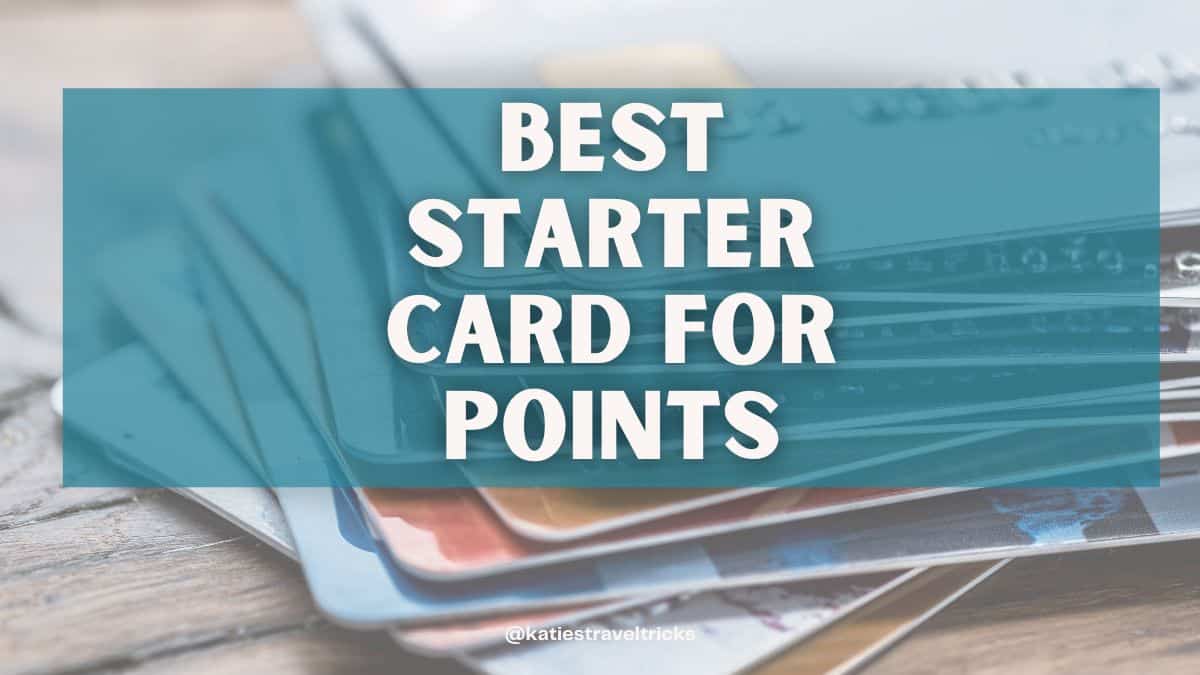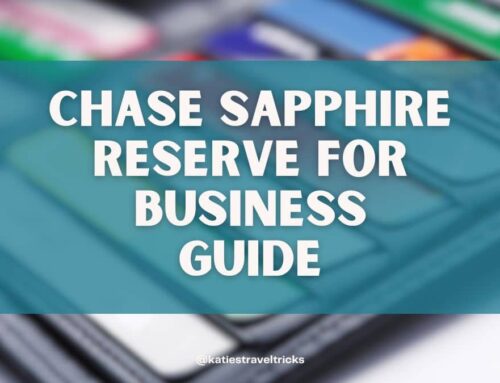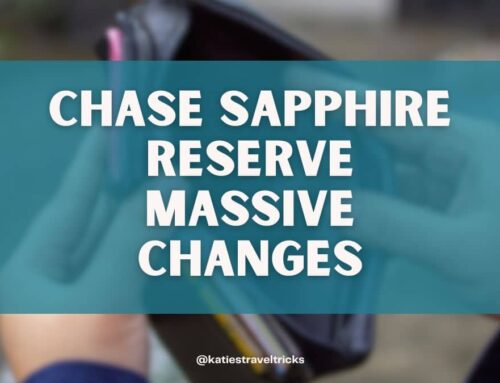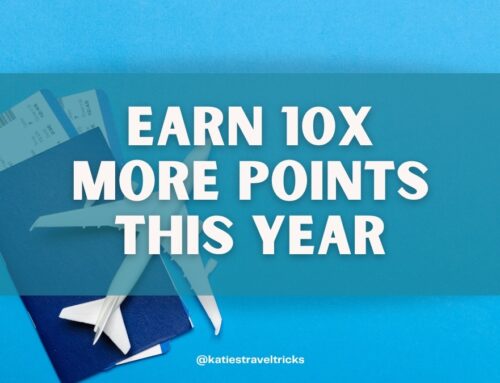All content was accurate at the time of publication. Check issuer’s site for most up to date information.
Katiestraveltricks.com site has partnered with CardRatings for our coverage of credit card products. Katiestraveltricks.com and CardRatings may receive a commission from card issuers. This compensation may impact how and where links appear on this site. This site does not include all financial companies or all available financial offers. Terms apply to American Express benefits and offers. Enrollment may be required for select American Express benefits and offers. Visit americanexpress.com to learn more. For Capital One products listed on this page, some of the above benefits are provided by Visa® or Mastercard® and may vary by product. See the respective Guide to Benefits for details, as terms and exclusions apply.
The Best First Credit Card for Points
Once you start to pay attention to travel points, you are going to start noticing credit card offers everywhere you look. Some of that is because of the way that internet advertising works. As soon as you start searching for something, or even talking about something near your phone, you’re going to see those advertisements popping up on your phone.
You’ll also start to notice this in places you may have previously ignored. It’s like when you go to buy a new car and you start noticing that car everywhere on the road. Because you’re starting to tune into it.
You’re going to start noticing credit card offers more and more, but it is really important that you don’t open every single card that you see, even the ones that might seem to have a really high bonus.
Tune out the (marketing) noise
The first thing I recommend is putting some blinders up. You’re going to have to tune out the noise of credit card marketers, who are really good at doing their job.
Credit cards are a huge money maker for banks. They are also a huge money maker for airlines. Airlines sell their miles to banks when they have an agreement involving a co-branded credit card.
There are stats that show loyalty programs accounted for for roughly 40% to 50% of airlines’ market value in 2019.
That year, United generated $5.3 billion from the sale of miles. Delta sold $4 billion in airline miles to banks, which is equal to 14% of its operational revenue.
Airlines want you to sign up for their card because banks pay them for those bonus miles. Banks want you to sign up for their credit card because they make a lot of money when people don’t pay off their cards on time and they can charge them upwards of 20% interest. They also make money every time you swipe your card at a merchant.
Everybody wants your business. You will get mailers, see flyers, and noticed ads to try to convince you to sign up for an offer.
To make it even more confusing, how far a point can go towards a trip can vary widely depending on the loyalty program.
You might see a welcome offer for 150,000 points in a magazine and think, “Wow, that’s a great offer. I should get that one.” But there are some 150,000 point offers out there that don’t go nearly as far as some 60,000 point offers.
The learning of all of that takes time. I’ve been doing this for over a decade and have an internal sense about different points programs. You can’t learn all of those point systems and kind of have a sense of how far each kind of points go instantly.
The other thing to be aware of is that offers change throughout the year on the same credit card.
So to take Delta as an example, it’s not uncommon to see the same Delta cards vary from a 40,000 mile welcome offer all the way up to a 90,000 mile offer.
Just because you see an ad for a 40,000 mile offer on a Delta card, doesn’t mean it is a great offer to jump on.
My point here is that you can’t trust the banks or the airlines to be marketing what are truly the best offers to you.
Best Starter Card: Chase Sapphire Preferred® Card
This is actually something that most creators and bloggers in the travel points world agree on.
I recommend starting with the Chase Sapphire Preferred® Card. I like this card for the value, the benefits, and the points. Already have this one? Move on to reading my Three Year Plan to see where to go next in your strategy.
The Points You’ll Earn
This card earns a points currency called Chase Ultimate Rewards®.
Ultimate Rewards are such an important and valuable rewards currency that I spent most of the first season of my podcast talking about them!
The points that you’re going earn on your Chase Sapphire Preferred are a flexible rewards currency. This means that you can use them in a variety of ways. They are so flexible that I had to have several podcast episodes to talk about the different ways that you can use them.
Looking for some ideas right now? Check out this post with 20+ trips you can take with Ultimate Rewards.
Overall – being a flexible rewards currency is really good news! That’s why I can recommend this card to everyone. There is a way that everyone can use these points for something that they value.
Here’s a broad overview:
- Cash out your Chase Ultimate Rewards for straight cash back. If you have 60,000 Ultimate Rewards, you can get $600 cash back.
- Use your Ultimate Rewards to book a flight, a hotel, or a car rental via Chase TravelSM. If you do this, your 60,000 Ultimate Rewards are worth $750 of travel, so they go a little further than cash back.
- Transfer your points toChase’s airline and hotel partners to book flights and hotels. This has the ability to unlock more theoretical value.
Overall, these points are valuable and they’re really flexible.
I also like Ultimate Rewards because there are multiple card options to earn them. In my Three Year Plan, I walk you through exactly how to do that.
Why you want this early
Chase has some of the most clear rules when it comes to when they will approve you for credit cards.
Overall, this travel points hobby is a dance with banks that issue cards. It’s not profitable for a bank to have a customer sign up for a card, spend the bare minimum required to earn a welcome offer, and then move on.
So through the years, banks have created different rules and added terms into card applications to try to curtail people just signing up for cards and dumping them soon after earning a bonus.
More so than other banks, Chase has a clear rule on the frequency you can open credit cards if you want to be able to apply for Chase cards.
This is know as the Chase 5/24 rule.
It is because of the Chase 5/24 rule, that it is best to start with Chase cards early on.
If you don’t focus on Chase cards first, you may lock yourself out of the ability to get them later. So that’s another reason I recommend starting with Chase cards first – and specifically the Chase Sapphire Preferred.
Solid Benefits
For a card with a $95 annual fee, this includes some important travel benefits like primary rental car insurance as well as including trip cancellation, interruption or delay coverage, and baggage delay coverage. You can more see my full guide to this card.
It also has the shopping benefits that I think that everyone should have a card with, like extended warranty benefits.
It also has perks like a $10/month credit to use at DoorDash.
Learn more about these benefits in these podcast episodes:
Low annual fee
If you cringe at the idea of paying an annual fee, know that cards with annual fees have better benefits and perks than cards without annual fees. And better welcome bonuses too!
If you are really averse to a fee, know that you can hold this card for one year and then downgrade the card to a no annual fee card or close your account. We don’t think you will — we think this one’s a keeper!
Best Time to Apply
The Sapphire Preferred will require you to spend a certain amount in the first three months of the card to earn a welcome offer. Offers may vary, check current offers here. So you have to be able to do that and you have to be able to pay it off in order to get the welcome offer on this card.
You get the welcome offer regardless of whether you pay it off but you need to pay it off for this to be worthwhile, because paying interest would negate any additional value.
This welcome offer sometimes changes. But as a general rule, I don’t recommend waiting to start opening cards until you see an elevated or limited time offer. That’s because you’ll earn more by just regularly opening offers than by always waiting for an elevated offer.
How much do you have to know about the points system before you apply for a card?
I think it can be tempting to want to wait to open a card until you feel like you understand everything.
But one thing I would encourage you to do is just open a card and see how it goes from there. If you open a card today, you have three months while you’re doing your spending to learn more before you’re even going to have your points.
One quick tip: If you think your spouse might start opening cards for points too, don’t automatically add him/her as an authorized user since authorized user cards count towards one’s 5/24.
Ready to learn how to apply? Learn how here (my affiliate link).
Responses are not provided or commissioned by the bank advertiser. Responses have not been reviewed, approved or otherwise endorsed by the bank advertiser. It is not the bank advertiser’s responsibility to ensure all posts and/or questions are answered.






